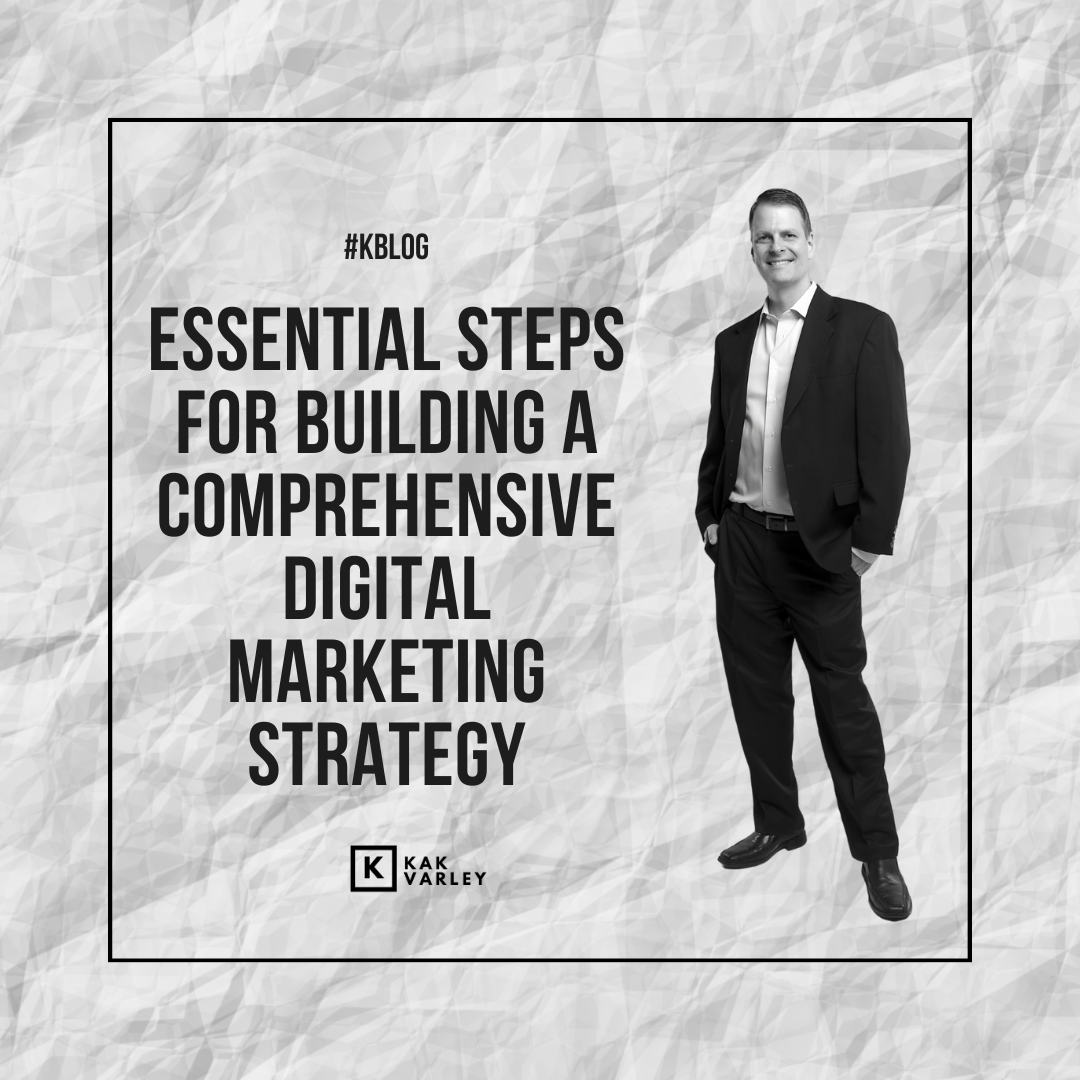
A comprehensive digital marketing strategy is vital for businesses looking to thrive in today’s ever-changing online landscape. To achieve success, it is important to understand the essential steps involved in building a comprehensive digital marketing strategy and follow them diligently.
Building a comprehensive digital marketing strategy involves a series of crucial steps that need to be taken in order to create an effective plan. These steps include understanding the difference between a marketing strategy and tactics, building accurate buyer personas, setting goals and identifying the necessary tools and channels, evaluating existing digital assets, and bringing all digital marketing campaigns together to achieve desired results.
Key Takeaways:
- Understand the difference between a marketing strategy and tactics.
- Create accurate buyer personas to target your marketing efforts effectively.
- Set clear and measurable goals and identify the necessary digital marketing tools.
- Evaluate your existing digital channels and assets to optimize strategies.
- Bring all digital marketing campaigns together for integrated and consistent messaging.
Understanding the Difference Between Strategy and Tactics
When it comes to digital marketing, it’s crucial to grasp the distinction between strategy and tactics. While both are essential components of a successful marketing plan, they serve different purposes and require different approaches.
A marketing strategy is the overarching plan that outlines your long-term goals and the direction in which your business should move. It involves a high-level analysis of your target audience, market positioning, and competitive landscape. A strategy is characterized by its broad scope, focusing on the big picture and the overall objectives you aim to achieve.
On the other hand, marketing tactics are the specific actions and methods used to execute your strategy and achieve short-term objectives. Tactics are more granular and immediate, focusing on implementing specific marketing activities such as content creation, social media advertising, or email campaigns. Tactics are characterized by their narrow scope and their ability to drive specific outcomes.
To illustrate the difference further, think of a marketing strategy as the blueprint for your digital marketing efforts. It provides a framework for decision-making and guides your overall approach. Tactics, on the other hand, are the tools and actions you use to bring that strategy to life.
By understanding the difference between strategy and tactics, you can develop a more cohesive and effective digital marketing plan. A well-defined strategy sets the foundation for your marketing efforts, while carefully selected tactics help you execute that strategy and achieve your desired outcomes.
Building Buyer Personas
Building accurate buyer personas is a crucial step in creating a comprehensive digital marketing strategy. Buyer personas are representations of your ideal customers and help you target your marketing efforts effectively. To develop accurate buyer personas, you need to gather both quantitative and qualitative information about your target audience.
Quantitative information includes demographics such as location, age, income, and job title. This data provides you with a basic understanding of who your target audience is and helps you segment your marketing campaigns accordingly.
Qualitative information delves deeper into the psychographics of your audience. This includes understanding their goals, challenges, hobbies, interests, and priorities. Gathering qualitative information allows you to create buyer personas that are not only accurate but also valuable for your business.
| Quantitative Information | Qualitative Information |
|---|---|
| Location | Goals |
| Age | Challenges |
| Income | Hobbies |
| Job Title | Interests |
By combining both quantitative and qualitative information, you can create detailed buyer personas that provide insights into your target audience’s motivations, preferences, and behaviors. These personas serve as a guide for crafting personalized marketing messages, choosing the right channels, and tailoring your marketing campaigns to meet the specific needs and desires of your target audience.
Remember, buyer personas should be regularly updated and refined as you gather more data and insights about your target audience. By constantly staying in tune with your customers’ evolving needs, you can ensure that your digital marketing strategy remains relevant and effective.
Setting Goals and Identifying Digital Marketing Tools
Setting clear and measurable goals is a crucial step in building a comprehensive digital marketing strategy. By defining specific objectives, you can track your progress and ensure that your efforts align with your overall business objectives. Google Analytics and CRM platforms are valuable tools that can help you measure the success of your digital marketing campaigns and make data-driven decisions.
Once you have identified your goals, it’s important to determine the digital marketing tools that will help you achieve them. Content marketing is a powerful tool for attracting and engaging your target audience. By creating high-quality, relevant content, you can establish your expertise, build trust, and drive organic traffic to your website. Website optimization is another essential tool that focuses on improving the user experience, increasing website visibility on search engines, and driving conversions.
Email marketing is a highly effective tool for nurturing leads and converting them into customers. By creating personalized and targeted email campaigns, you can build relationships with your audience, deliver valuable content, and drive sales. These tools, along with others such as social media marketing, search engine optimization (SEO), and digital advertising, play a crucial role in achieving your digital marketing goals.
Examples of Digital Marketing Tools
| Tool | Description |
|---|---|
| Google Analytics | A web analytics tool that provides valuable insights into website traffic, user behavior, and conversion rates. |
| CRM platforms | Customer Relationship Management platforms help businesses manage customer interactions, track leads, and optimize sales processes. |
| Content Marketing | A strategic approach to creating and distributing valuable content to attract and engage a target audience. |
| Website Optimization | The process of improving various elements of a website to enhance user experience, increase visibility on search engines, and drive conversions. |
| Email Marketing | The use of email campaigns to deliver personalized and targeted messages to nurture leads, build customer relationships, and drive sales. |
By setting goals and identifying the right digital marketing tools, businesses can create effective strategies that drive results. It’s important to continuously measure progress, analyze data, and make adjustments as needed to optimize your campaigns and achieve your digital marketing objectives.
Evaluating Existing Digital Channels and Assets
When building a comprehensive digital marketing strategy, it is crucial to evaluate your existing digital channels and assets. This evaluation will help you identify areas of opportunity and make data-driven decisions to optimize your strategies. By analyzing the performance metrics of each channel and asset, you can determine which elements are successful and refine your strategies accordingly.
One way to optimize successful elements is by analyzing the data from your website. Identify the pages that attract the most traffic, have the highest conversion rates, or generate the most engagement. Use this information to refine your website’s design, content, and functionality to enhance user experience and drive better results.
Similarly, evaluating your social media accounts can provide valuable insights into audience engagement and content performance. Determine which platforms and types of content resonate the most with your target audience, and allocate your resources accordingly. Additionally, consider refining your social media strategies based on the feedback and interactions you receive from your followers.
Optimizing your digital marketing strategies also involves analyzing search engine optimization (SEO) efforts and digital advertising. Evaluate the keywords that drive organic traffic to your website and identify opportunities for improvement. Refine your SEO techniques to increase your website’s visibility in search engine results.
Furthermore, analyzing your digital advertising campaigns can help you identify underperforming areas. Review the metrics such as click-through rates (CTR), conversion rates, and return on ad spend (ROAS). Consider refining your targeting, ad creatives, or messaging to improve your campaign’s performance and maximize your advertising budget.
| Digital Channels | Performance Metrics | Optimization Strategies |
|---|---|---|
| Website | Traffic volume, conversion rate, engagement | Refine design, content, and functionality based on data |
| Social Media | Audience engagement, content performance | Allocate resources to platforms and content that resonate with your target audience |
| Search Engine Optimization (SEO) | Organic traffic, keyword rankings | Refine SEO techniques to increase website visibility |
| Digital Advertising | Click-through rates, conversion rates, return on ad spend | Optimize targeting, ad creatives, and messaging for better campaign performance |
By evaluating your existing digital channels and assets, and refining your strategies based on the data collected, you can enhance the overall effectiveness of your digital marketing efforts. This ongoing evaluation process will ensure that you are making informed decisions and continuously optimizing your strategies to achieve your digital marketing goals.
Bringing Digital Marketing Campaigns Together
Now that you have evaluated your existing digital channels and assets, it’s time to bring all your digital marketing campaigns together. Integrated marketing is key to ensuring consistent messaging across all channels and creating a seamless customer journey. By integrating your email marketing, social media marketing, content marketing, and paid advertising efforts, you can deliver a cohesive brand experience that resonates with your target audience.
Consistent messaging is vital for building brand recognition and establishing trust with your customers. By maintaining a unified voice and visual identity across all your digital marketing campaigns, you can reinforce your brand’s value proposition and enhance your overall brand perception.
Tracking and measurement are also essential components of bringing digital marketing campaigns together. By implementing tracking tools such as Google Analytics, you can monitor the performance of your campaigns and gain valuable insights into customer behavior. This data-driven approach allows you to make informed decisions and optimize your strategies for better results.
Key Metrics for Tracking and Measurement
| Metric | Description |
|---|---|
| Conversion Rate | The percentage of website visitors who complete a desired action, such as making a purchase or filling out a form. |
| Click-through Rate (CTR) | The percentage of people who click on a specific link or advertisement, indicating the effectiveness of your call-to-action. |
| Return on Investment (ROI) | The measure of profitability from your digital marketing efforts, calculated by comparing the cost of investment to the resulting revenue or value generated. |
| Customer Acquisition Cost (CAC) | The average cost your business incurs to acquire a new customer, including marketing expenses and sales efforts. |
By monitoring these key metrics and analyzing the data, you can identify areas of improvement, eliminate underperforming strategies, and allocate resources more effectively. This constant tracking and measurement process ensures that your digital marketing campaigns are consistently optimized for success.
Overall, bringing digital marketing campaigns together involves integrating your efforts, maintaining consistent messaging, and tracking and measuring your performance. By adopting a holistic approach and leveraging the power of data-driven insights, you can maximize the impact of your digital marketing strategy and drive meaningful results for your business.
Conclusion
Building a comprehensive digital marketing strategy requires following essential steps to ensure success. By understanding the difference between strategy and tactics, you can lay the foundation for a strong plan. Creating accurate buyer personas helps target your marketing efforts effectively while setting clear goals and identifying the necessary tools and channels ensures you’re on the right track.
Evaluating your existing digital channels and assets allows you to optimize successful elements and refine strategies for underperforming areas. Bringing all your digital marketing campaigns together through integrated marketing ensures consistent messaging and a seamless customer journey. And don’t forget the importance of tracking and measuring your campaigns to continually improve your strategies.
By following these essential steps, you’ll be able to build a comprehensive digital marketing strategy that can drive your business forward in the ever-changing online landscape. Remember, a well-planned and executed strategy is key to achieving your digital marketing goals.
If you need any inbound marketing, Kak Varley Marketing provides digital marketing agency services to their clients. Which, inbound marketing is one of their main focuses.
FAQ
What is the difference between a marketing strategy and marketing tactics?
A marketing strategy is a high-level plan that guides the direction and long-term goals of your business, while marketing tactics are specific actions and methods used to implement your strategy and achieve short-term objectives.
Why are buyer personas important in digital marketing?
Buyer personas are representations of your ideal customers and help you target your marketing efforts effectively. They provide valuable insights into the demographics and psychographics of your target audience.
How do I set clear and measurable goals for my digital marketing strategy?
Tailor your goals to your business objectives and use tools like Google Analytics and CRM platforms to measure your progress and success.
What are some essential digital marketing tools I should consider?
Content marketing, website optimization, and email marketing are some of the essential digital marketing tools that can drive website traffic, improve search engine rankings, and generate leads and conversions.
How do I evaluate my existing digital channels and assets?
Analyze the performance metrics of each channel, including your website, blog content, social media accounts, SEO efforts, and digital advertising. Optimize successful elements and refine strategies for underperforming areas.
How do I bring all my digital marketing campaigns together?
Coordinate your email marketing, social media marketing, content marketing, and paid advertising efforts to deliver a cohesive brand experience. Track and measure the success of your campaigns to make data-driven decisions and optimize your strategies.
#kakvarley #kakapproved #ktip #kblog



